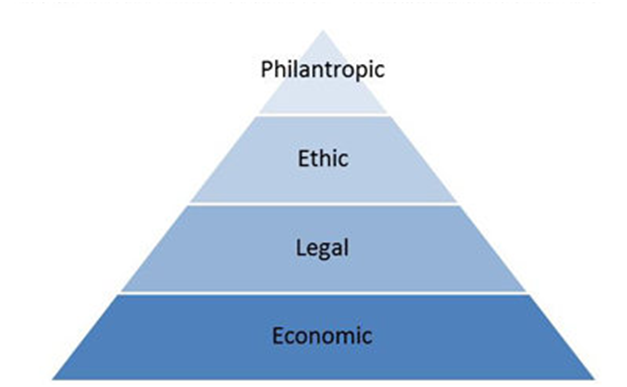Carrol’s CSR Pyramid and It’s Relation to Modern Environment
The concept of CSR Pyramid, proposed by Carroll (1983) divides business obligations into four levels, explaining requirements of obligations in each level, as well as their importance.
Economic responsibility is considered to be core responsibility of the business and it relates to profit maximisation. Economic responsibility is mainly self-regulatory in a way that if a business entity neglects or fails to meet its economic responsibilities it is just a matter of time before the business becomes a history.
Legal responsibility of a firm relates to adhering to rules and regulations of the respective government. Meeting legal responsibilities is critically important for businesses and the case study of Enron can be mentioned to explain the potential negative consequences of abusing legal responsibilities.
Ethical responsibilities for a business entity relate to certain responsibilities that go beyond basic economic and legal requirements for a business entity. Ethical responsibilities are usually expected by organizational stakeholders, but usually there are no government laws and regulations to enforce these responsibilities. However, each case is different and there might be instances where governments may interfere in relation to ethical issues.
Philanthropic responsibility is understandably placed at the highest level of responsibilities because it is not generally expected and mainly initiated for advertisement and public relations purposes. Philanthropic acts engaged by businesses may include sizable donations to various causes or local communities, or contributing to society in other ways.
Although Carroll’s CSR Pyramid is widely considered to be a substantial contribution to the development of the field of CSR, it has been criticized by various authors. Hockerts et al. (2008) criticise this framework by arguing that there is no need to represent CSR as a hierarchy. In other words, according to Hockerts et al. (2008), unlike Maslow’s Hierarchy of Needs, in Carroll’s CSR Pyramid there are weak or no relationships between CSR activities involved in each level.
Moreover, further criticism relate to making no distinctions between corporate citizenship and philanthropy, and ambiguity if Carroll’s CSR Pyramid is a descriptive or normative model.
References
Hockerts, K, Casanova, L, Gradillas, M, Sloan, P, & Jensen, E. (2008) ‘An Overview of CSR Practices Response Benchmarking Report’, INSEAD Working Papers Collection, 67, pp. 1-50

